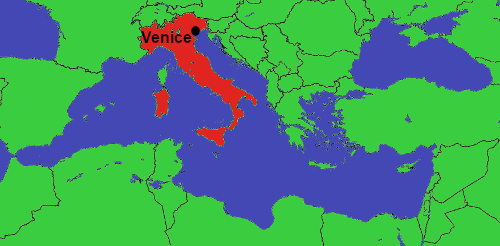
Circle the area on this map

D. The World Ocean is the interconnected system of the Earth’s oceanic waters and covers 139 million square miles and 70 percent of the globe’s surface. It is divided into oceans, including the Atlantic, which include seas like the Mediterranean and its subdivisions such as the Adriatic.
B. A sirocco is a wind that comes out of the Sahara Desert in northern Africa and is pulled northward by storm systems in the Mediterranean. Strong storms last week pushed the winds northwest into the Adriatic Sea, trapping high seas along its northern shore and flooding the historic city of Venice.
C. The sack in 410 was the first time in almost 800 years that Rome had fallen to a foreign enemy, and it is seen as the as a major landmark in the fall of the Western Roman Empire. About three centuries after the empire fell, the Republic of Venice rose to become a powerful city-state that lasted about 1,000 years before being conquered by Napoleon Bonaparte and then being ruled by Austria and later Italy.
A. Nearly 250 million acres have burned across Australia since September, and fire chiefs worry that it will get worse with the start of the Southern Hemisphere’s summer next month. While Venice is flooding more and more frequently, many officials in Australia say that country’s raging wildfires have become a “new normal” because of climate change.